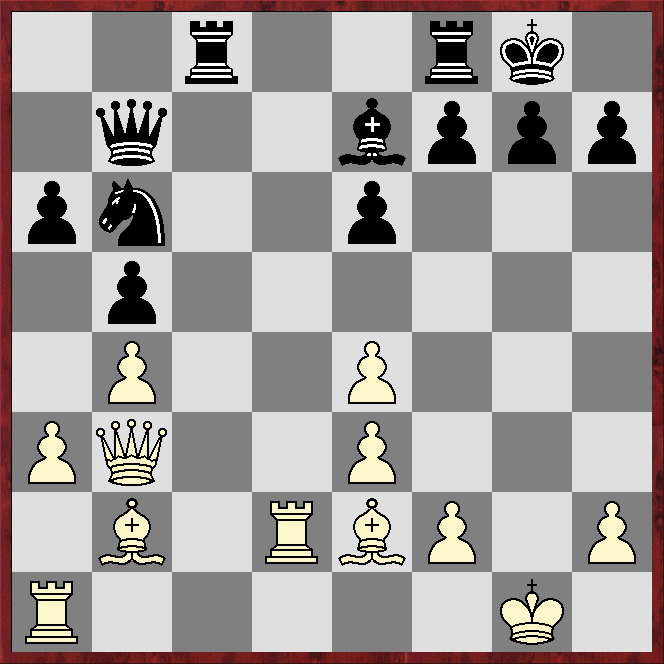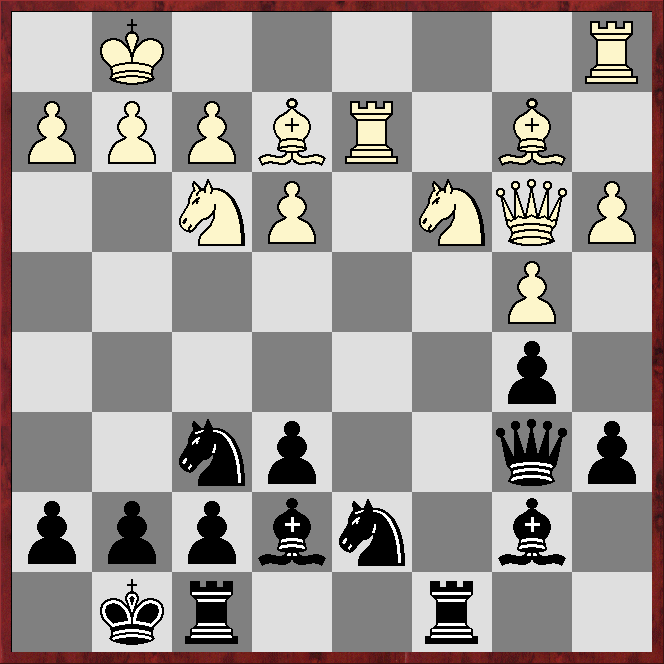His score of +6=3-0 meant he finished a half-point ahead of the field of 181 players.
Perhaps his most important win came in round eight, with black against then joint-leader Gottfried Schumacher (2102), a German Fide master.
Schumacher (2102) - Schneider-Zinner (2335)
Queen's Gambit Declined
1.d4 Nf6 2.Nf3 d5 3.c4 e6 4.Nc3 Be7 5.e3
 |
| The somewhat passive, or at least slow, 5.e3 is probably the oldest continuation in the position, dating back to 1881 in ChessBase's 2024 Mega database |
*****
*****
*****
*****
Seven years were to pass before Johannes Zukertort introduced 5.Bf4 in a loss to Amos Burn at the British Chess Association congress in London.
And another four years passed before Salomon (aka Samuel) Lipschütz played 5.Bg5 in a draw against Jackson Showalter in their match for the US championship.
5...0-0 6.Bd3 dxc4 7.Bxc4 a6
Black plans to both expand on the queenside with ...b5, in the process gaining a tempo on White's light-square bishop, and to pressure the white centre with ...c5 and ...Bb7.
*****
*****
*****
*****
8.a3
The stem game, Abram Rabinovich - Dawid Janowski, Prague 1908, saw White prevent Black's expansion with 8.a4, the game continuing 8...c5 9.0-0 Nc6 10.dxc5 Bxc5 11.Qe2 Qc7 12.e4 Ng4!? with a slight edge for Black, according to Stockfish16 and Komodo14.1 (0-1, 37 moves).
Most popular in Mega24 is 8.0-0, reaching a position Hikaru Nakamura played with white in at least three online blitz games in 2020, winning all three. A typical continuation runs 8...b5 9.Bd3 Bb7, when most popular in Mega24 is 10.a3, but Nakamura (2763) preferred 10.Qe2!? in his blitz win over Sanan Sjugirov (2663).
8...c5 9.0-0 b5 10.Be2!?
The engines reckon this and 10.Ba2 are roughly equal in value, but they are not so keen on 10.Bd3, the point seeming to be that in many lines White plays dxc5, when, with the black queen's knight developed to d7, ...Nxc5 hits White's light-square bishop.
10...Nbd7 11.dxc5 Nxc5 12.b4
*****
*****
*****
*****
The white queen's knight is more actively placed than its black counterpart, but the latter can go to b6, from where it will eye the important c4 and d5 squares. Meanwhile White's dark-square bishop will be obstructed on b2. Nevertheless it is White to move, and that can be important in symmetrical (and near-symmetrical) positions. The engines reckon the position is equal.
13.Bb2 Bb7 14.Qb3 Qb6 15.Rfd1 Rac8 16.Rd2!?
The engines prefer completing development with 16.Rac1, claiming Black is slightly better after the text.
*****
*****
*****
*****
16...Bxf3!?
This seems to be a novelty. Known is 16...Rfd8, while the engines suggest, among other moves, 16...Bc6!? (Stockfish16) and 16...h6 (Komodo14.1.
17.gxf3!?
This is Stockfish16's choice. Komodo14.1 marginally prefers 17.Bxf3 Ne5 18.Be2 Nc4 19.Bxc4 Rxc4 20.Rad1.
17...Qb7 18.Ne4?!
The engines suggest 18.f4!?, fighting for the e5 square, or 18.Rad1.
18...Nxe4 19.fxe4 Nb6
 |
| White's bishop-pair does not fully compensate for the damaged pawn-structure, according to the engines |
*****
*****
*****
*****
20.Rad1!?
Hoping activity will compensate for being a pawn down, but the engines prefer defending the pawn, either directly with 20.f3 or 20.Bd3, or indirectly with 20.Bd4.
20...Qxe4 21.Ba1?!
Perhaps hoping to set up a battery on the long dark diagonal, but Black will always have ...Bf6, and anyway the process is slow. The engines suggest 21.Rd4, but give Black at least the upper hand.
21...Bf6
Even stronger, according to the engines, is 21...Qg6+ with ...Nc4 likely to follow.
22.Rd6?
The engines give 22.Qd3 Qh4 23.Bxf6 Qxf6 24.Qd4, albeit preferring Black.
22...Bxa1 23.Rxb6
Or 23.Rxa1 Nd5!?, when White's lack of coordination spells trouble, eg 24.Re1!? Rc3 25.Qb2 Qg6+ 26.Kh1 Qf5 with strong pressure, or 24.Rxa6 Nc3 (the reason why the engines suggest 24.Re1!?) 25.Qb2 Qg6+ 26.Kh1 Qf5 27.f3 Rfd8, after which White has regained the sacrificed pawn but still suffers from poor coordination.
23...Rc3?!
23...Rc3?!
Black is winning after this, according to the engines, but much stronger is their suggestion of 23...Be5.
24.Qa2
After 24.Qb1! Qxb1 25.Rxb1 Rxa3 Black is two pawns up, but opposite-coloured bishops and the weakness of a6 give White hope, eg 26.Bf3 Bf6 27.Bb7 Rb8 28.Rxa6 Rxa6 29.Bxa6, when White has won back a pawn and there is a long way to go before Black can hope to exploit the extra kingside pawn.
24...Rc2 25.Qxa1 Rxe2 26.Qd4 Qf3?!
Much stronger is 26...Qg6+, and if 27.Kf1 then 27...Qc2, when White cannot defend both f2 and d1.
27.Rf1 Rc8 28.Qe5?
Necessary is 28.Qf4, when 28...Qxf4 29.exf4 Re4 30.Rxa6 Rxf4 leaves Black a pawn up in a rook-and-pawn ending, which is far from clear.
28...Rxf2! 0-1



No comments:
Post a Comment